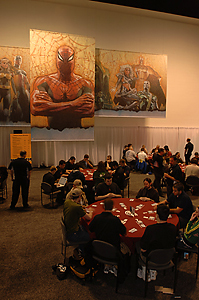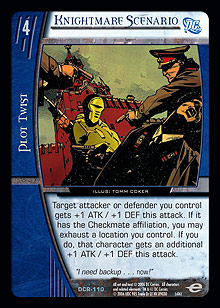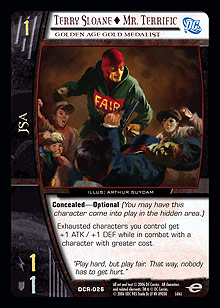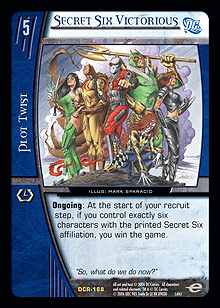
In the last couple of articles, I have waded through the different available Constructed archetypes. While these deck types are not new, they can serve as an aid in future deck construction for pro and casual players alike. Today, I am going to take it one step further and discuss with you the available deck archetypes in the Infinite Crisis Draft format. This article will not be a card-by-card guide or a mock draft (check out Alex Brown’s superb articles for that content), but instead will give you real-life examples of the different deck archetypes that I have built and played. Hopefully, we can learn from my experiences and together become better players.
Draft History
 So, before we get into the draft analysis, I figured it was only fair to let you know a little bit about my evolution as a Sealed Pack player. To be honest, when I first started playing this game, I was not that interested in Sealed Pack play. I wanted to build a Doom deck and just play it over and over again. As I started to develop a competitive eye toward the game, I felt that my Sealed Pack play would not be a liability and that my Constructed skills were more important. Well, let me tell you, I could not have been more wrong.
So, before we get into the draft analysis, I figured it was only fair to let you know a little bit about my evolution as a Sealed Pack player. To be honest, when I first started playing this game, I was not that interested in Sealed Pack play. I wanted to build a Doom deck and just play it over and over again. As I started to develop a competitive eye toward the game, I felt that my Sealed Pack play would not be a liability and that my Constructed skills were more important. Well, let me tell you, I could not have been more wrong.
I was in prime position at the first Pro Circuit to win a good deal of money and possibly Top 8. I was 21st after Day 1 and ready to roll. But Day 2 was a blur of losses. I ended up 1-8 on the day, and my one win was a bye. I was shocked. I figured that my knowledge of the cards would be more than sufficient to get me to a decent finish Day 2. I don’t remember my exact finish, but I know that it was really disappointing.
So, how did I bounce back from that performance? And more importantly, how can you bounce back from a performance on par with the flop I just described? Well, I practiced. I drafted as much as possible. That seems rather obvious, but it’s funny how the simple things get overlooked. It’s often easy to say, “Well it wasn’t my fault, I just wasn’t getting the cards I needed.” But that actually means you likely didn’t read signals correctly or were trying to force a strategy that just wasn’t there. And how do you fix that? Well, like I said before: practice. Practice means more than just selecting cards and slamming them down into a pile. It means paying attention to what you pass, to what’s passed to you, and to what archetypes work in any given Draft format.
As I continued to practice and learn how to draft, I began to learn how to read signals and pass fake ones. Then, at Pro Circuit Atlanta, it all came together with a 7-2 Draft record. The transformation didn’t happen overnight—it took a steady course of about a year of practice and hard work. But don’t get me wrong, I’m not saying that it takes everyone that long to get a grasp on Draft. But for me, that’s how much time I needed for things to click.
To be honest, I almost felt like it was a fluke. I knew that I had worked hard and had consequently become a better player, but at the same time, I just wasn’t sure. As I approached Pro Circuit San Francisco, I continued the same strategy of drafting as much as possible, talking Draft concepts and strategy, and just looking at cards to try to find interactions. Well, it paid off again with a 6-3 record; two of my three losses were to eventual Top 8 finishers.
So now that you know a little bit about my past performances, you can be confident that what follows has been thought through and played. I am by no means the authority on Draft, and some of my concepts may be rough around the edges or even wrong. Hopefully, what follows will aid you in preparation for your next draft, whether it is at Pro Circuit Indianapolis or your local shop.
DISCLAIMER: Before I start with how to build a deck archetype, I want to stress that this article is not a Draft guide. Instead, it’s an analysis of when you take a given drop for each Draft set. Specific cards can, and generally do, change your strategy. If you open a bomb that sets you in a specific team or strategy, then you need to be flexible to go in that direction. What follows is what you do after you are set in a specific team or deck archetype.
Curve-Based Decks
This is by far the most common deck type in Draft. It is generally the easiest to build and normally provides the most success (in my experience). The curve is obviously adjusted in Draft, given that you are playing half the number of characters. Generally, I try to go with nineteen characters and eleven non-characters. Those numbers can go up or down depending on your personal preference, but that is what I will work from today. For a curve deck in a Draft environment, here is what I imagine the distribution to look like:
1-drops: 0-4
2-drops: 4
3-drops: 4-5
4-drops: 4-5
5-drops: 3-4
6-drops: 2-3
7-drops: 1-2
So, the first thing we need to discuss is how to fill out that skeleton. In drafting a curve deck, character selection is important. Speaking in generalities, I believe that drafting your low curve early is important. I say this because every deck needs a low curve, some more than others (more on that later), so you will be competing with every deck archetype for these slots. If you whiff on turns 1 and 2, you are in a big hole against an opponent that hits either of those drops. So, I generally take 2-drops early if they are strong. Obviously, not every pack will provide you with the perfect set of cards, so you need to be flexible and know when to take what. But I think that as a general rule, taking your low curve early is a sound strategy.
As you go through your selections, you need to be wary of where and when you draft your curve. As I said before, curve decks generally provide the most success, but they can be a resounding failure when the curve is not adequately filled out. I often have a hard time picking up 6-drops in this format.
Personally, I have had moderate success building curve decks in this environment. Villains United has some of the best individual characters in the format, and building a curve deck around them makes for a strong overall deck. The ability of their characters to hold down opposing deck archetypes, such as short-curve (with Mr. Freeze, Brutal Blizzard’s vengeance) and off-curve (with Dr. Psycho, Mental Giant’s vengeance), seems to suggest that they may be tailor made to thrive in this archetype.
Short-Curve
This concept is one that I have had a great deal of success with in this format. I love drafting this archetype, as it is by far the easiest for me and feels the most natural. The curve generally looks something like this:
1-drops: 2-4
2-drops: 4-6
3-drops: 4-5
4-drops: 4-6
5-drops: 4-5
6-drops: 0-2
Conceptually, this deck archetype doesn’t look like much. Much like the curve-based decks, taking low-curve characters early is really important, especially since this deck tends to run more than the normal curve deck (but not as many as a pure off-curve deck). Not taking 7- or 6-drops tends to open up your selection somewhat, because when other players are filling those drops, cards you need may slide down to you.
 In my experience, this deck archetype has only proven a contender in one team. That team would be Checkmate, specifically using a deck revolving around the version Knight. Many of the Knight characters will wheel, so taking key Checkmate plot twists, such as Knightmare Scenario or Brother Eye, is a good play. The deck that I have had success with runs off Harry Stein and uses the aforementioned curve. By pumping up your characters, you have the necessary firepower to brickwall attacks and force through the damage necessary to beat curve-based decks. Also, Roy Harper ◊ Arsenal, Knight is a beating against any deck, as he can generally hold down all deck archetypes if you have necessary support cards like Harry Stein, Secret Checkmate HQ, Knightmare Scenario, and Target Acquired, among others.
In my experience, this deck archetype has only proven a contender in one team. That team would be Checkmate, specifically using a deck revolving around the version Knight. Many of the Knight characters will wheel, so taking key Checkmate plot twists, such as Knightmare Scenario or Brother Eye, is a good play. The deck that I have had success with runs off Harry Stein and uses the aforementioned curve. By pumping up your characters, you have the necessary firepower to brickwall attacks and force through the damage necessary to beat curve-based decks. Also, Roy Harper ◊ Arsenal, Knight is a beating against any deck, as he can generally hold down all deck archetypes if you have necessary support cards like Harry Stein, Secret Checkmate HQ, Knightmare Scenario, and Target Acquired, among others.
I honestly can’t tell you if this deck concept will work with other teams, as my attempts to force it have not yielded any favorable results. I do know that the above Checkmate build is a force and should be considered when drafting this set.
Off-Curve
I have had no success drafting this archetype in this set. However, I have seen numerous other individuals, such as the illustrious Tim Batow, wreck with it. Maybe I don’t have the mind to wrap around this concept, but I will try to discuss the strategy adequately. Generally, the curve looks something like this:
1-drops: 4-6
2-drops: 4-6
3-drops: 4-6
4-drops: 4
5-drops: 2-4
The deck skeleton looks a lot like a short-curve build. Really, it’s not that far off from a short-curve deck. The only difference is that off-curve builds prefer to under-drop. In this deck, low curve selection is of the utmost importance, perhaps even at the cost of a playable plot twist or location. The early drops will not float around to you because every other deck archetype employs them, as well. The fact that you need to play more low-curve characters than the average deck makes them a tougher commodity to come across.
 This deck archetype is generally founded upon Michael Holt, Mr. Terrific and Terry Sloane, Mr. Terrific. Michael Holt is generally first picked, as he sets you firmly in this archetype. The fact that his ability is team stamped obviously means that you will need either to fill up on JSA characters or take a few Team-Ups. After that, it’s pretty much business as usual, taking low-cost characters or plot twists that give ATK pumps across the board (such as Surveillance Pawn or Thanagarian Invasion).
This deck archetype is generally founded upon Michael Holt, Mr. Terrific and Terry Sloane, Mr. Terrific. Michael Holt is generally first picked, as he sets you firmly in this archetype. The fact that his ability is team stamped obviously means that you will need either to fill up on JSA characters or take a few Team-Ups. After that, it’s pretty much business as usual, taking low-cost characters or plot twists that give ATK pumps across the board (such as Surveillance Pawn or Thanagarian Invasion).
As stated before, this deck prefers to under-drop, and the reason it does not play a 6-drop is that under-dropping two 3-drops on that turn can be more beneficial. Also, it creates a more reinforceable field, limiting not only breakthrough but also stun damage. I don’t think I need to explain the difference between a 6-drop and 3-drop stunning. Granted, playing this deck will sometimes mean that you will not be able to force a stunback, so cards like Defend Yourself! or Rann are beneficial for trying to accomplish that goal.
I have seen other players try to force this deck type without the Terrific brothers, to little success. The deck may be able to exist outside of the JSA, but at least to me, it seems very limited and must contain Michael Holt in order to be a contender.
Combo Decks
 I honestly didn’t give this concept much thought at all. I mean, seriously, is this even possible in Draft? Well, it may or may not be. I was speaking with Adam Prosak about the possibility of a Secret Six Victorious build. Speaking in generalities, Secret Six Victorious almost always wheels to you. So, if you wanted to try to build this deck, you would have to see that card swing by in the first four to five picks to know to draft with that angle.
I honestly didn’t give this concept much thought at all. I mean, seriously, is this even possible in Draft? Well, it may or may not be. I was speaking with Adam Prosak about the possibility of a Secret Six Victorious build. Speaking in generalities, Secret Six Victorious almost always wheels to you. So, if you wanted to try to build this deck, you would have to see that card swing by in the first four to five picks to know to draft with that angle.
This deck concept runs off a curve build, as it needs to have six characters in play. The biggest detriment is that many of the key cards are either rare or uncommon. Lex Luthor ◊ Mockingbird is needed if you plan to get off the win on turn 5. However, it is much more realistic to get a turn 6 win. With Ragdoll recovering him- or herself (Is it a guy or girl? I do not know, but if you do, please email me and explain!) every turn and Catman hanging out in the hidden area, you just need to hit your curve. You can bring Deadshot, Dead Aim into the hidden area, and Cheshire will stick around as your one recovered character. So, you need to find a way to get those two other characters into play. Luckily, Parademon and Fiddler both come into play rather easily. But without cards like It’s Not Over Yet or Dodge the Bullet, I’m not sure if you can get the win.
What’s nice about this deck is that even though you may be building with an eye toward a combo, the deck also operates as a curve-based deck. Cards like Ragdoll and Cheshire are strong on their own, so you still have a backup plan if the combo doesn’t show up.
I have never drafted this deck type, though it is my understanding that Tommy Ashton has done so to some success. Whether that success had anything to do with Secret Six Victorious or was simply the result of beating his opponent down with a curve deck is unknown to me. But if you are just doing a casual draft for the fun of it, I suggest trying this archetype if you can (I know I will!). If anything, it may be a fun alternative to an otherwise “strictly business” Draft mentality.
In the End
I have had my difficulties with Infinite Crisis, and I can only hope that by reading this article, you can see the different deck possibilities a little more clearly. As I said before, there is no hard and fast rule concerning deck construction in either Sealed Pack or Constructed. You, as the player, have to be able to identify what works, what is being passed, and what you are passing. (Again, if you need help in this area, allow me to defer to the master, Alex Brown.) Once you have made those decisions, deck construction should be much easier.
If you have any questions or comments for me, please feel free to contact me at piercedlawyer@yahoo.com.